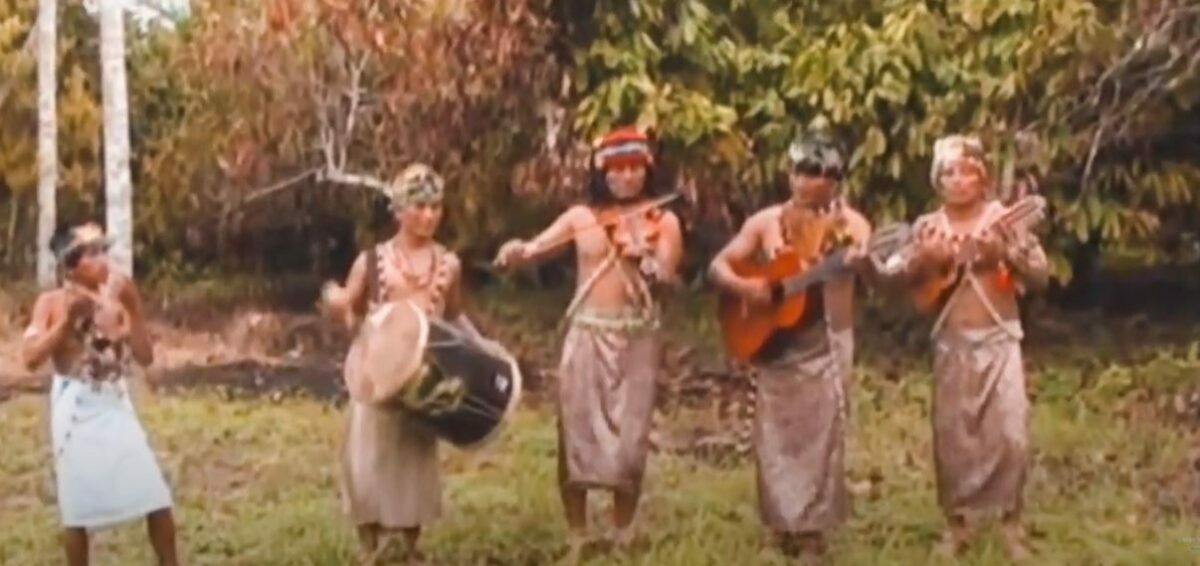
The Kichwa people (or Quechua of Ecuador) have developed their culture through generations, encompassing different expressions, including music through which they can express their emotions and beliefs.
“The music was practiced by the parents who told the story of their ancestors in this way, they sang to teach the importance of the natural elements and the gods… this was done in the mornings where they shared the wayusa (or guayusa )”
(Grefa, 2017)
Music of the Ecuadorian East
According to Gerardo Guevara, author of the popular songbook “Let’s sing” (1992), the Ecuadorian musical tradition has its origins in 2 pre-Hispanic rhythms and their dances, the Yumbo and the Danzante, being the first one originally from eastern Ecuador, both use the drum or bass drum, but while the Yumbo uses a trochaic metric foot, the dancer uses an iambic metric foot. Both the Yumbo and the Danzante use a compound binary compass (6/8) but while the yumbo presents a lively allegreto movement, the dancer on the other hand is calmer.
Another hypothesis is that from the mixture of the yumbo and the dancer, with its syncopated elements, a “creole dance with a lively spirit” (Salgado, 1952) emerges, baptized as “Aire typical”, which is said to be related to another genre. typical musical of Ecuador, the albazo which has a compass of 3/4.
Kichwa music as a form of expression
This artistic form is intimately related to the environment in which these indigenous peoples of the Amazon-Ecuador , mixing both the natural and the social, inspired by the sounds of nature that surrounds them to create music for religious purposes that, being closely linked with the rituals of the jungle, acquire a sacred touch.
Shamanism as a ritual form of these peoples, uses music as a fundamental part, for the ceremonies instrumental touches and songs are performed to connect with the spirits and gods that give them guidance and healing.
Through music, these tribes have managed to transmit their heritage and cultural values for generations, where their religious beliefs and their relationship with the environment that surrounds them are expressed. It is also used as a means to impart knowledge of the history of the communities, always expressing their emotions and feelings.
Division of the musical forms of the Kichwa
According to the ” Study on the cultural expressions of the Amazonian Kichwa Nationality of eastern Ecuador (Aguinda, 2021) in indigenous communities, music can be classified as follows:
naturalistic music
Naturalist-type music is inspired by the environment, the sounds of the jungle , through which they express their love for their habitat and the struggle for survival. To this is added the festive music that is played in celebrations such as marriages and births, paying tribute to fertility and the indelible links between the jungle and people.
funeral music
In the ceremonial part we find the funeral music, which inspired by the sounds of the birds expresses sadness for the loss, but at the same time celebrates the fact that by closing the cycle of life, a return to the source of life represented by the jungle itself is achieved.
Yachai music (ritual)
Songs are also used for shamanic rites to honor the power of the elements and animals that they consider sacred, such as the jaguar , the alligator and the boa.
Traditional songs: “Sasi”
There is also an important variety of traditional songs, these are considered a genuine representation of feelings, therefore, for each emotion there is a different type of song.
The tradition referring to the correct way of interpreting the songs asks the interpreters to carry out a rite that is known as “Sasi”, in which men are prohibited from eating meat at the moment before performing a intonation already that could attract evil spirits during ceremonies.
As for the lyrics, they usually name the deep bond with nature, pay homage to their animals and tell stories about their myths and legends .
At present, these musical forms have begun to mix due to external influences on the communities, forming a syncretism of cultures. It is necessary to maintain in young people the knowledge of the deep cultural heritage of these communities expressed in the relationship between man and nature.
“Before, there were ritual songs in which women and men performed, in the case of women, songs to not lose and grieve her husband, for which they went to the mountain or to a river and those sounds carried the river, the toucans and those ritual songs were already lost with the grandparents who died in the 70s, those are the songs that can now be seen in few Kichwa women in Pastaza, this tradition was lost due to the interference of the mestizo into the Kichwa territories.”
Cesario Andi, elder of the Capirona community (Aguinda, 2021)
Musical instruments
The Yachay use musical instruments such as the guadua flute and the turtle shell, and even the same rudimentary weapons used for hunting and fishing are also used as instruments.
Shuar Music of the Amazon Ecuador

Sources
- Sandoval, J.M. (2009). Patrimonial music of Ecuador (p. 129). Ministry of Culture of Ecuador. PDF
- Aguinda, A., & Sisa, C. (2021). Study on the cultural expressions of the Amazonian Kichwa Nationality of eastern Ecuador (Bachelor’s thesis, Quito: UCE). PDF Source
- Andy, P., Calapucha, C., & Calapucha, L. (2012). Wisdom of the Kichwa culture of the Ecuadorian Amazon. Cuenca: UNIVERSITY OF CUENCA
- Grefa Tapuy, AM (2017). THE KICHWA MUSIC IN THE PRACTICE OF ANCESTRAL DANCES OF THE STUDENTS OF THE TARQUI BASIC EDUCATION SCHOOL OF THE TAMBAYACU COMMUNITY, CANTON ARCHIDONA, PROVINCE OF NAPO, YEAR 2014-2015 (Master’s thesis, Ambato: Universidad Tecnologica Indoamerica).
- Guevara, Gerardo. Let’s Sing: Popular Songbook . Program “Ecuador Studies”, 1992.
- Salgado, L. (1952). Ecuadorian vernacular music. Microstudy. Quito, House.

Gerson Alvarado, Comunicador Social egresado de la ULA Táchira, Venezuela. Actualmente desempeñando funciones de Comunicador y Reportero Audiovisual. Fotógrafo, Músico y Ciclista. Apasionado por captar imágenes de paisajes y documentar historias.

Daniel Osorio holds a BA in Social Communication with a mention in Communication for Humanistic Development (Universidad de Los Andes, 2005). Film and TV director and screenwriter. Specialist in Digital Marketing (SEO, SEM, Adwords, Adsense). General Manager (CEO) at DMT Agency. He is the founding editor of the portal delamazonas.com among others.
This post is also available in:
![]() Español (Spanish)
Español (Spanish)
